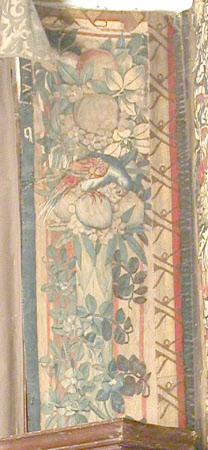Border fragments
probably Brussels
Category
Tapestries
Date
circa 1535 - circa 1550
Materials
Tapestry, wool and silk, 6 warps per cm
Order this imageCollection
Cotehele, Cornwall
NT 348250
Summary
A set of two border fragments, tapestry, wool and silk, 6 warps per cm, Southern Netherlands, c. 1535-1550.
Full description
This pair of mid sixteenth-century tapestry borders at Cotehele do not match any of the tapestries in the house. Both are vertical side borders. The design, with fruit, flowers and animals arranged around a central palm trunk, is of a type that was extremely popular in Brussels tapestry during the period c. 1535-1550 and derives ultimately from the great tapestry series designed by Bernard van Orley, such as the ‘Hunts of Maximilian’. Derivative borders continued to be used into the second half of the sixteenth century, for example on a series of the ‘Story of Elijah’ in the Museo d’Arti Applicate, Milan (Forti-Grazzini 1984, pp. 19-22). One of the two border strips has a partial Brussels mark (in the form of an upside-down small letter ‘b’) and a partial maker’s mark with the letters ‘I F V A’ attached on the left hand side. Although both marks are woven into sections of blue galloon similar in quality to the galloons joined to the borders, they have been sewn on and may not originally be from the same tapestry or set. (Helen Wyld, 2010)
Provenance
First recorded at Cotehele c. 1840; left at Cotehele when the property was accepted in lieu of tax from Kenelm, 6th Earl of Mount Edgcumbe (1873-1965) and transferred to the National Trust in 1947; amongst the contents accepted in lieu of estate duty by H M treasury and transferred to the National Trust in 1974.
Credit line
Cotehele House, The Edgcumbe Collection (The National Trust)
Makers and roles
probably Brussels , workshop
References
Forti-Grazzini, 1984: Nello Forti-Grazzini, Museo d'arti applicate. Arazzi (Musei e Gallerie di Milano), Milan 1984


